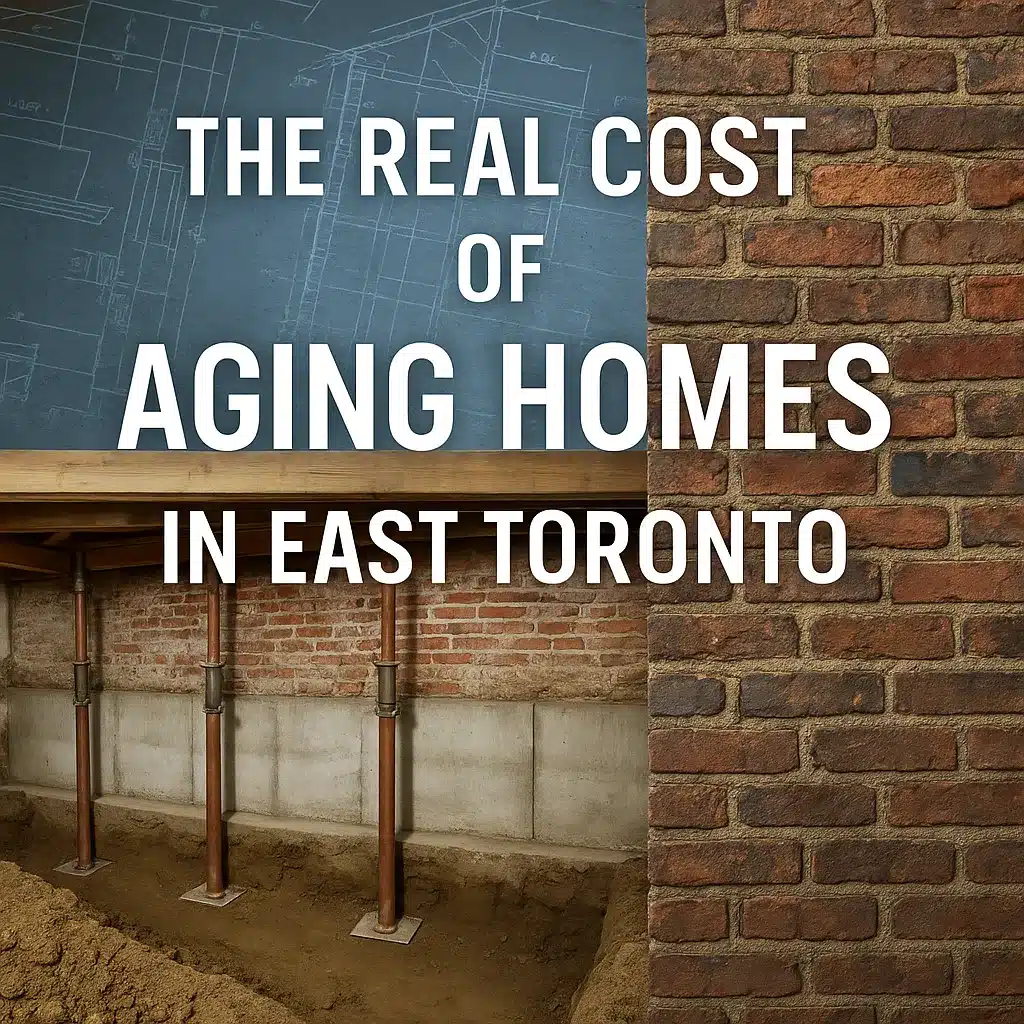Intro
East Toronto’s homes have character — brick façades, narrow driveways, tall trees, and endless charm. But behind those vintage exteriors lie the realities that make these homes some of the most complex and costly to renovate in Canada.
At Woodsmith Construction, we’ve spent over two decades working on older homes across Leslieville, Riverdale, East York, and the Beaches. The challenges we face daily explain why quotes vary so wildly — and why real renovations here require real expertise.
The Foundation Problem: Brick, Not Concrete
Most East Toronto homes weren’t built with modern concrete foundations. They sit on multi-wythe clay brick foundation walls — far weaker than poured concrete or even rubble stone.
These foundations:
Wick water like sponges, pulling moisture up through the walls.
Flake and crumble over time under lateral soil pressure.
Deform under load if excavated too close or too wide during underpinning.
Unlike newer homes, these foundations were dug only to the frost line, leaving basements around 6’3″–6’5″ high. Today’s living standards demand at least 8 ft of finished height, which means underpinning is almost always required.
WOODSMITH INSIGHT:
Brick foundations can’t handle wide underpinning sections. Where concrete allows 4 ft sections, brick must be done in 2–3 ft increments, doubling the work and inspection cycles — but it’s the only safe way to prevent collapse.
Water Infiltration: The Hidden Enemy
After a century of moisture migration, most East Toronto basements leak — even if you can’t see it yet. The city’s clay soil traps water, and frost cycles push that moisture straight into old brick.
Mortar joints deteriorate, allowing seepage through hairline cracks.
Hydrostatic pressure builds behind foundation walls, forcing water inward.
Sill plates and joist ends rot, compromising the floor structure above.
Even “finished” basements often hide wet insulation, rusted fasteners, or mold inside walls.
WOODSMITH INSIGHT:
Many older homes were never meant to be watertight below grade. Finishing them without foundation waterproofing and drainage only traps moisture — guaranteeing future failure.
Rough-Sawn Lumber: Why Walls Aren’t Straight
Homes built before the 1950s used rough-sawn lumber, cut by hand or early mills — meaning no two pieces are the same.
Studs vary in thickness by up to ½ inch.
Joists twist and bow over time.
Lath and plaster walls hid these flaws, but modern drywall exposes them.
Renovating means reframing walls and ceilings just to get flat surfaces. Every room requires new levelling, shimming, or sistered framing before drywall or cabinetry can be installed.
WOODSMITH INSIGHT:
Drywall doesn’t hide old framing — it highlights it. We often spend days truing walls before the first finish goes up, and that time is rarely accounted for in low quotes.
The Partial Reno Trap
Over the years, many East Toronto homes have been “updated” one room at a time — a new kitchen in the 90s, a finished basement in the 2000s, spray foam in the attic a few years later.
The problem? These piecemeal upgrades disrupt airflow and moisture balance throughout the house.
Air still passes freely through old framing cavities.
Sealed rooms (like a spray-foamed attic) trap moisture in cooler, uninsulated walls below.
Condensation collects, causing hidden mold, rot, and even structural weakening.
WOODSMITH INSIGHT:
When only parts of an old house are sealed, moisture doesn’t stop — it reroutes. That’s why we often find more damage behind newer renovations than in untouched originals.
Access, Parking, and Staging: The East Toronto Tax
Renovating in Leslieville or the Beaches is a logistical nightmare compared to suburban jobs.
Narrow streets and one-way lanes limit delivery access.
No driveways mean every load of debris or materials must be hand-carried.
No place for dumpsters means frequent, costly haul-outs.
Tight lots mean trades literally work elbow-to-elbow.
These factors add hours of labour per day, not inefficiency — just the reality of the site.
A project that takes eight months in Mississauga might take a year in East Toronto — not because of the builder, but because of where the house sits.
When Underpinning Becomes the Only Option
To achieve modern comfort, underpinning isn’t optional — it’s the foundation of a proper renovation.
Key Facts:
Modern concrete or block underpins can be cut in 4 ft sections.
Brick foundation underpins must be done in 2–3 ft sections for safety.
That means twice the inspections, twice the excavation steps, and far more engineering oversight.
Skipping underpinning or doing it incorrectly risks catastrophic wall failure — something we’ve seen too often in East Toronto.
Why Cheap Quotes Rarely Hold Up
Low quotes often come from contractors who price as if they’re building on concrete, not soft brick, or assume easy site access that doesn’t exist.
Without factoring underpinning limits, framing irregularities, or water infiltration, those “simple renovations” balloon in cost mid-project — or worse, get abandoned halfway through.
Why Woodsmith Construction Takes the Design-Build Approach
At Woodsmith Construction, we start by designing for your home’s reality, not its wish list.
Our design-build process means:
We evaluate structural and waterproofing conditions before design.
Our in-house design and construction teams collaborate early, avoiding rework.
You get realistic budgets tied to engineering realities.
That’s how we deliver better outcomes — not just better finishes.
Closing Call to Action
If you’re planning to renovate an older home in East Toronto, understand that the charm comes with challenges — and the only way to manage them is through thoughtful design-build planning.
👉 Contact Woodsmith Construction to start your renovation the right way — with an honest look at what your home truly needs before you spend a dollar on finishes.







